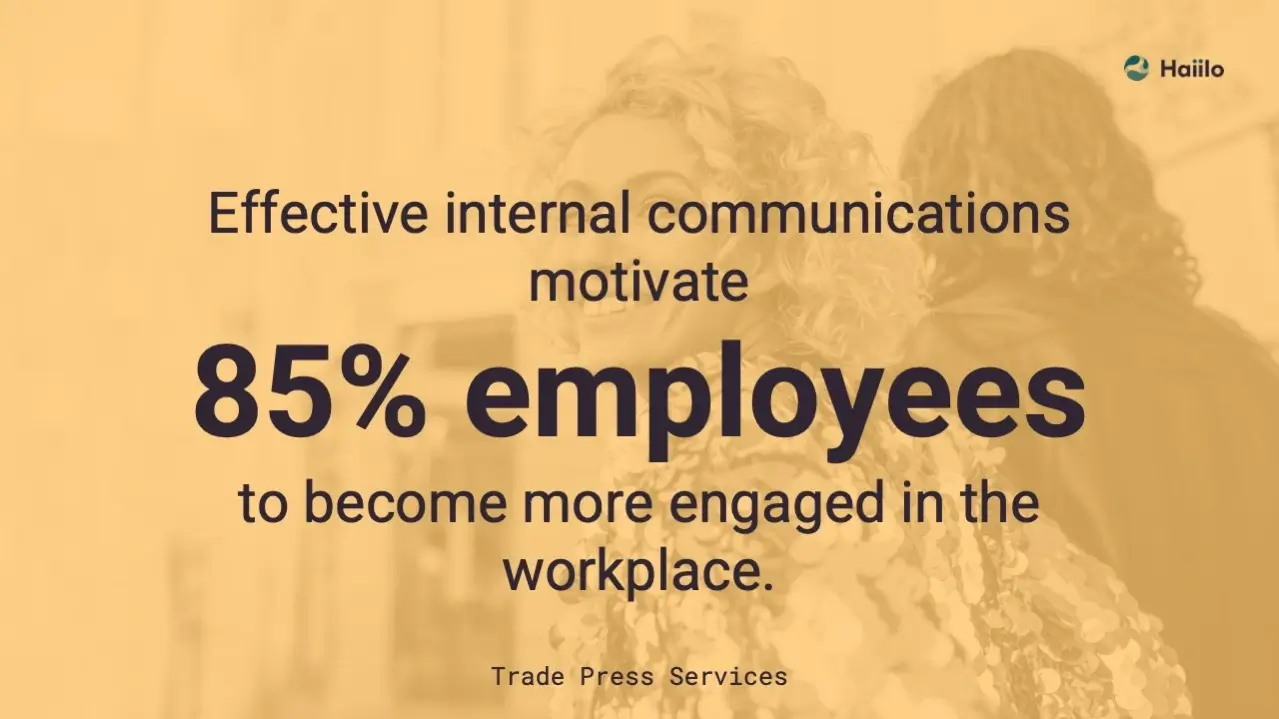Defining communication goals is not easy. Why? Because measuring the impact of communication has never been an easy job for communications professionals.
No matter whether we talk about internal or external communication, putting a number behind every communication initiative is challenging.
Still, that doesn’t mean that communication shouldn’t be more data-driven!
In this blog, we will talk about how to define business communication goals and share some of the best communication goal examples.
📚 Before we move forward, get our brand new Employee Engagement Report 2022!
Communication Goals Defined
When we talk about business, we often hear terms such as “marketing goals” or “sales goals”. Communication goals, on the other hand, are not so commonly mentioned.
In the past few years, however, communications professionals are expected to be more goal-oriented and set expectations behind their investments and activities.

Defining the term “communication goals” with a single sentence is hard mostly because there are many different types of communication. Internal communication, external communication, corporate communication, digital communication, and brand communication are just some of the communications-related terms that all have different meanings.
In this blog, we will focus on defining the goals for internal business communication.
How to Define Communication Goals in Your Organization
The cost of inefficient communication in the workplace can be significant. According to research:
- $37 billion is the total estimated cost of employee misunderstanding (including actions or errors of omission by employees who have misunderstood or were misinformed about company policies, business processes, job function, or a combination of the three)
- $26,041 is the cumulative cost per worker per year due to productivity losses resulting from communications barriers
- Companies that have leaders who are highly effective communicators had 47% higher total returns to shareholders compared with firms that have leaders who are the least effective communicators
It’s no secret that communication touches various aspects of business and has a direct impact on organizational success.
To define your communication goals, the best is to start from the biggest challenges your organization faces and then find ways proper communication can eliminate them.
For example, if you know that the search for information impacts your workers’ productivity, your communication goal should be to ease access to information for every employee.
If you are noticing low engagement with your internal newsletter, for example, your goal should be to improve readership and engagement.
To make this easier, we have identified some of the common communication goals companies have.
💡 Related: What is Organizational Communication and 9 Steps to Do It Right
9 Examples of Communication Goals
Every communication initiative should have its purpose. Even though it may be hard to measure communication in the workplace, more and more comms professionals are trying to be data-driven.
Because business communication is crucial for ensuring business continuity, especially during these times of uncertainty, it is important to put some goals and objectives behind communication campaigns.

Let’s take a look at some communication goals to consider for your organization.
Improve organizational alignment and productivity
Communication plays an important role in achieving better organizational alignment. And the fact that 95% of employees do not fully understand the company’s goals or what is expected from them to achieve these goals is worrying.
When there is misalignment, employee productivity also suffers because people are not working together toward achieving the same business goals.
It is not surprising, therefore, that one of the most common communication goals an organization can have is to achieve better alignment inside teams, among departments, and company-wide.
💡 Related: 8 Reasons Why Internal Communication Is the Key to Organizational Alignment
Optimize change management processes
During the last 3 years, companies across the world have been constantly undergoing significant changes. Mergers and acquisitions, digital transformation, the shift towards remote work, COVID-19 and the war in Ukraine are just some of these big changes affecting businesses all over the world. To be able to adapt to the current economic situation proper change management is absolutely necessary.
Since only 38% of people like to leave their comfort zone, adjusting to these changes is never easy, especially for large organizations with a dispersed workforce. Effective change communication strategy is a prerequisite for successful change management.
Reduce information overload (while increasing readership)
Some people say that there are no such things as too much information. They are wrong!
Moreover, information overload is one of the biggest productivity killers for workers. People are overwhelmed with information in both their personal and professional lives.
So an important communication goal for every company should be to reduce information overload by making it more personalized and relevant to the readers.
Unfortunately, many companies still don’t have the right processes and tools in place that can enable them to achieve that. Many are still sending generic, company-wide emails to every employee. As a consequence, people start ignoring these, they become less engaged, and they often miss important updates.
The fact that 74% of employees have the feeling they are missing out on company news is alarming!

Improve access to important information
Today, most employees use multiple tools to access the information they need to do their jobs successfully. There are project management tools, document management solutions, emails, messaging apps, social intranets, and many others.
It doesn’t surprise that, in this sea of various workplace technology, people often get lost and are unable to find critical information in a timely manner.
Communications professionals (HR professionals in smaller companies) are often responsible for ensuring easy access to critical company information for every employee. Additionally, managers and leaders play an important role in ensuring the same within their teams.
Boost team and cross-departmental collaboration
Hybrid and remote work often make it harder for people to collaborate properly. When there is no physical contact among people, silos become a big challenge.
Different communication skills among people can also result in some communication barriers. Companies should, therefore, have designated communication campaigns about effective team collaboration and team communication.
Drive more knowledge sharing
A communication goal to capture, manage, and transfer knowledge helps companies increase efficiency and promote internal learning and development. Knowledge transfer goes further than sharing information with people.
It requires organizations to create digital working environments in which people can easily discuss ideas, raise concerns, and ask questions.
Furthermore, we can’t rely on synchronous knowledge sharing anymore. Asynchronous-first communication is the new normal, and adjusting to these new trends is certainly the biggest communication goal every company should have.
Increase employee engagement
Storytelling can have a big power in increasing employee engagement in the workplace. Making content more interesting and relevant to the audience shapes a positive employee experience and can go a long way in improving employee motivation, productivity, and retention.
According to Trade Press Services, effective internal communications motivate 85% of employees to become more engaged in the workplace.

Furthermore, workplaces in which employees feel more connected to each other see higher employee engagement rates. It is important to enable people to stay connected to each other even when they are physically separated!
Gather more valuable feedback
You have probably heard many times that the best communicators are those who know how to listen and those who have good interpersonal communication skills. In fact, collecting valuable feedback should always be one of the top communication goals for individuals and organizations.
Workplace communication in which people feel like their voices are heard is necessary for building trust. This is why most companies today send regular employee surveys from which valuable feedback is collected.
💡 Learn about 8 tips to boost employee communications in your company!
Make communication more data-driven
As mentioned earlier, communication campaigns and initiatives should have clearly defined purposes and objectives.
Even though it’s not easy to measure the impact of every communication initiative, more and more communicators are trying to be data-driven. Not only that they are trying to tie communication goals to the company-wide OKRs but they are also implementing activities such as A/B tests enabling them to create and distribute content that better resonates with their audiences.
Achieving Your Communication Goals
Most of the above-mentioned communication goals are not so easy to achieve. Luckily, the emergence of the latest technology doesn’t make it mission impossible anymore.
Proper business communication plays a critical role in driving business success. So identifying and choosing the right set of tools and communication channels to improve organizational communication is a must.

Technologies like Haiilo enable employers to, firstly, make communication more relevant and engaging for the reader. It helps businesses reach the right people with the right messages at the right time, and it creates a digital working environment in which every employee can strive.
Furthermore, it enables employers, leaders, and managers to better understand their people and get valuable insights and recommendations for improvement.










